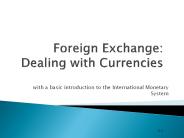Ambiguous Optimistic Fair Exchange - PowerPoint PPT Presentation
1 / 21
Title:
Ambiguous Optimistic Fair Exchange
Description:
Propose the notion of 'Ambiguous Optimistic Fair Exchange'; Provide a formal security model; ... Ambiguous OFE. PMGen system parameter generator. SetupTTP ... – PowerPoint PPT presentation
Number of Views:139
Avg rating:3.0/5.0
Title: Ambiguous Optimistic Fair Exchange
1
Ambiguous Optimistic Fair Exchange
- Qiong Huang
- Joint work with Guomin Yang, Duncan S. Wong and
Willy Susilo
2
Fair Exchange
- Gradual Release of Secret
- bit by bit
- Optimistic Fair Exchange
- Semi-trusted (offline) party
- Involved only when theres a dispute
3
Optimistic Fair Exchange
- Asokan-Shoup-Waidner ACM CCS 97
Valid?
Valid?
4
Optimistic Fair Exchange
- Dodis-Lee-Yum PKC 07
- Multi-user setting ?single-user setting
- Huang-Yang-Wong-Susilo CT-RSA 08
- Multi-user setting chosen-key model
5
Motivation of This Work
- Alices partial signature reveals her will!
- Everyone can verify that sP was generated by
Alice, or - Bob can show to anybody that Alice is the signer
of sP .
6
Motivation of This Work
- Alice and Bob sign a contract.
- Given Alices sP , Bob holds the execution and
turns to Ted for a higher price. - Unfair for Alice!
7
Related Work
- Garay, Jakobsson and MacKenzie. Abuse-free
Optimistic Contract Signing. Crypto 99. - No party can prove to others that hes capable of
choosing whether to validate or invalidate a
contract - A scheme based on DDH assumption in the random
oracle model - No consideration of multi-user setting
8
Related Work
- Liskov and Micali. Online-untransferable
signatures. PKC 08. - Enhanced version of DCS
- A dishonest, online recipient cannot convince
others the real owner of a signature - Complex, interactive signing
9
Our Work
- Propose the notion of Ambiguous Optimistic Fair
Exchange - Provide a formal security model
- Propose an efficient scheme
- w/o random oracles
- secure under the proposed model
10
Ambiguous OFE
- PMGen system parameter generator
- SetupTTP key generation for arbitrator
- SetupUSER key generation for user
- Psig, Pver
- partial signature generation and verification
- Sig, Ver
- full signature generation and verification
- Res resolve a partial signature to full one
11
Ambiguous OFE
- Each party has a key
- Resolution Ambiguity
- Signer Ambiguity
- Bob is able to produce sP similar with Alices
12
Ambiguous OFE
- Security against signers
- Security against verifiers
- Security against arbitrator
13
Signer Ambiguity
D
- Weak Signer Ambiguity
- PK0, PK1 are chosen by the challenger and given
to D. - D can corrupt PK1.
b b?
sPPsig(PM, APK, SKb, PK0, PK1, M)
14
Security Against Verifiers
B
- Weak Security Against Verifiers
- PKB is chosen by challenger.
- B can corrupt it.
- M, sF, PKB
- Ver(M, sF, PKA, PKB, APK) 1 ?
- (M, ., PKA, PKB) ? Query(B, ORes)
15
Theorem
Weak Signer Ambiguity
Weak Security Against Verifiers
Security Against Arbitrator
Similar with the relation between
indistinguishability security and one-way
security of public key encryption
Our proposed construction achieves the strong
versions of the security properties.
16
Building Tools
- BB short signature
- q-SDH assumption
- Kiltz tag-based encryption
- Selective-tag weakly CCA security
- DLN assumption
- Groth-Sahai NI proofs
- NIWIPK
- NIZK
- DLN assumption
- Strong one-time signature
17
The Scheme
NIWIa e(a, gH(otvk) PKA) e(g,g) ? e(a,
gH(otvk) PKB) e(g,g)
- Borrow the idea of Groths group signature
(Asiacrypt 07) - partial signature sP
- (otvk, otsk) a fresh one-time key pair
- s BB signature on H(otvk)
- p1 NIWIs was generated by either Alice or
Bob - y encryption of s
- p2 NIZKCmt in p1 and y contain the same
message - sOT one-time signature on (M, p1, y, p2, PKA,
PKB) - sP (otvk, sOT, p1, y, p2)
18
The Scheme
- full signature sF (sP, s)
- resolution
- Use the extraction key of NIWIPK or the
decryption key of the encryption scheme to
recover s
Theorem The proposed A-OFE scheme is secure in
the multi-user setting and chosen-key model
provided that DLN assumption and q-SDH assumption
hold.
19
Comparison
Non-Transfer. Level of non-transferability Effici
ency order of efficiency Interaction
interactive or non-interactive Setup-Free
whether a key registration is needed between the
trusted party and user RO with random oracles or
not
20
Conclusion
- Proposed the notion of A-OFE
- Provided a formal security model
- Proposed an efficient construction in the
standard model
21
Q A
Thanks!































